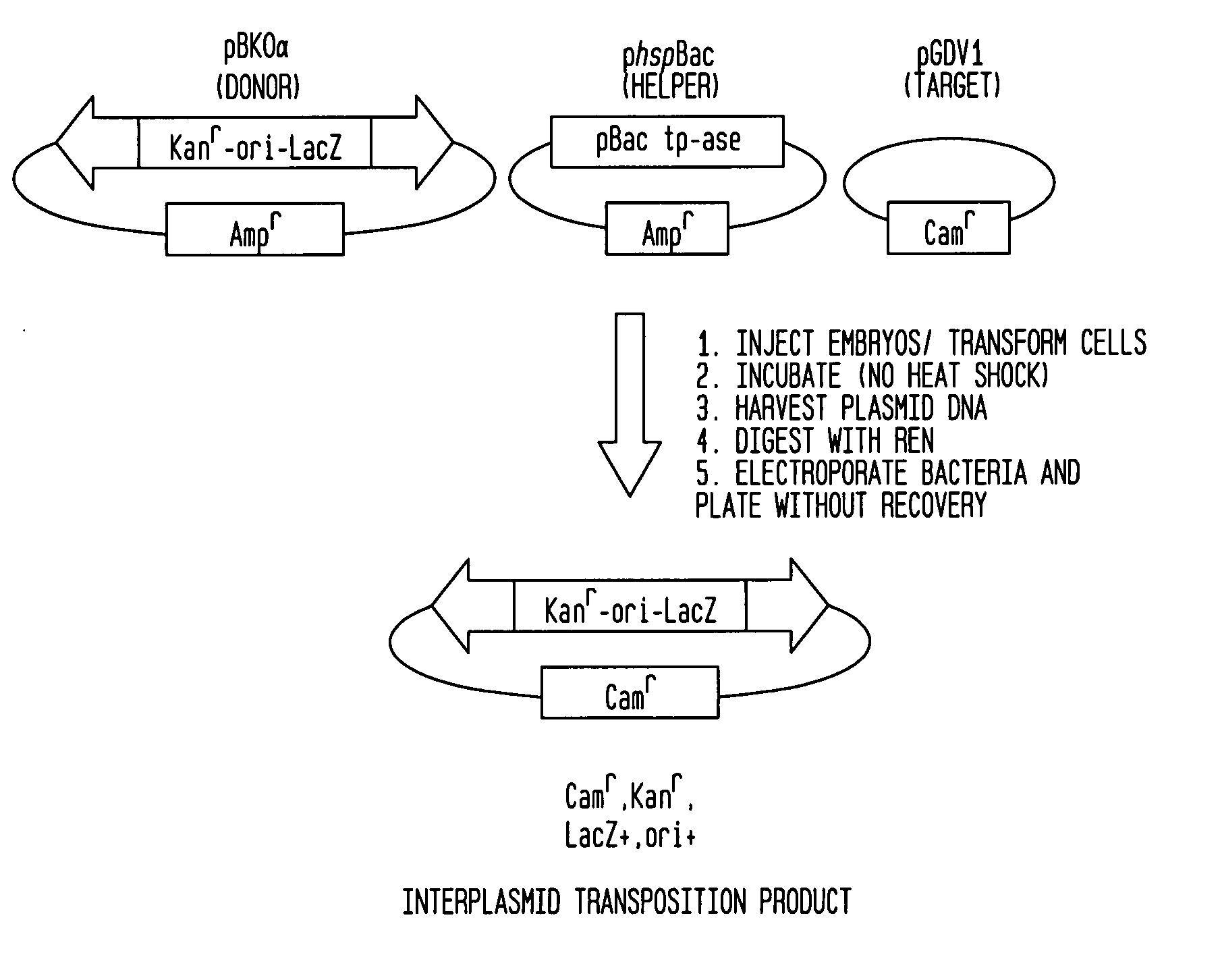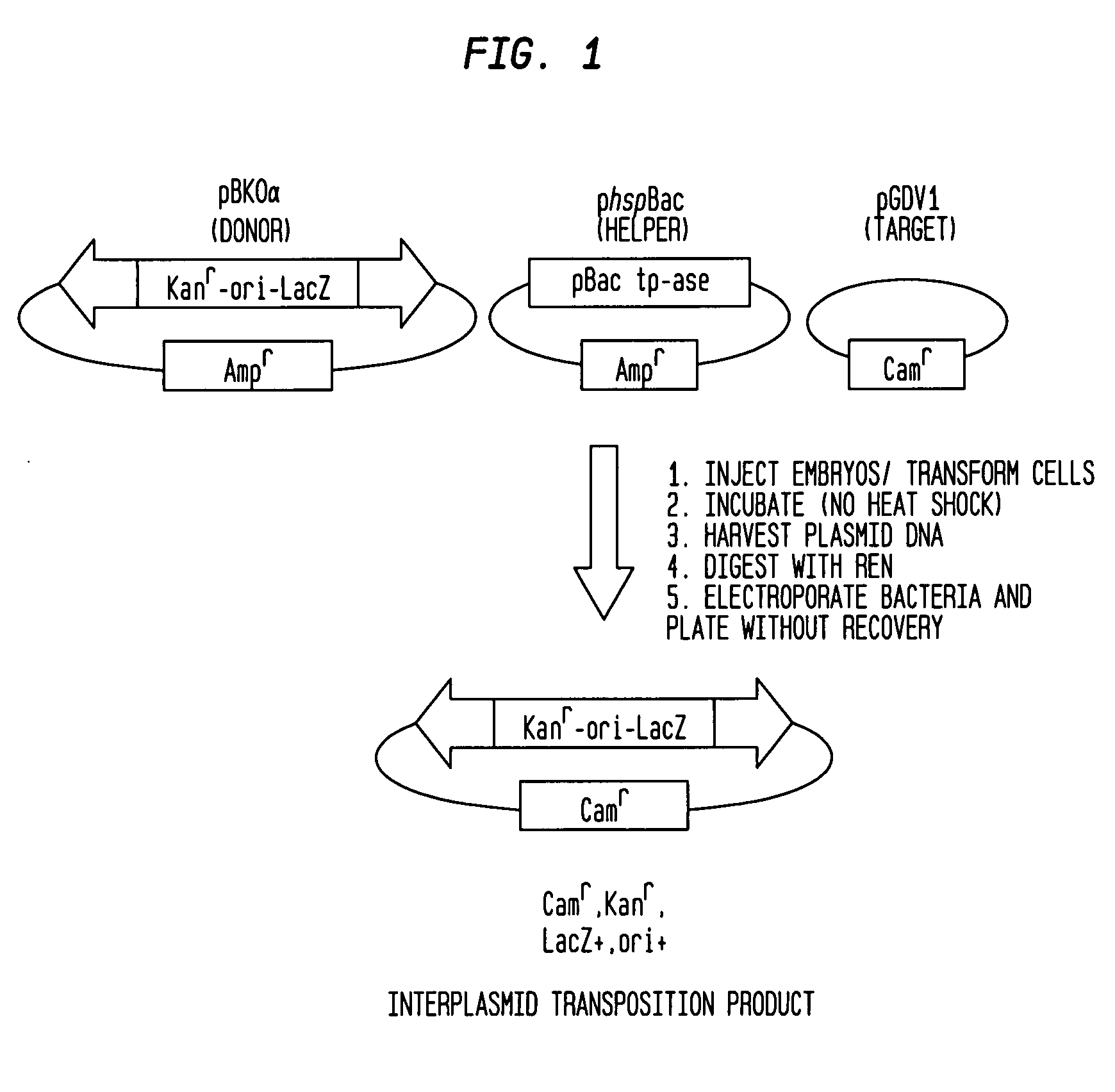PiggyBac constructs in vertebrates
a construct and construct technology, applied in the field of genetic tools, can solve the problems of presenting a biohazard, unable to produce retroviral vectors, and unable to meet the needs of transgenesis vectors,
- Summary
- Abstract
- Description
- Claims
- Application Information
AI Technical Summary
Benefits of technology
Problems solved by technology
Method used
Image
Examples
example 1
Methods
[0050] The present example provides a description of the materials and methods employed in the practice of the present invention.
[0051] Preparation of Plasmid DNAs:
[0052] Plasmid DNAs used for transfections or microinjections were prepared using the rapid boiling procedure and were purified by CsCl gradient centrifugation. Following collection of the supercoiled fraction and extraction of the ethidium bromide with isoamyl alcohol, the DNAs were dialyzed against four changes of 4000 volumes of 0.1×SSC and stored frozen at −20° C. until used. Because these plasmids were to be used for transfection of cell cultures they were handled as sterile reagents at all times. At no time were these DNAs subject to contamination with any other plasmids.
[0053] The target plasmid used in these analyses was pGDV1, a chloramphenicol resistance plasmid derived from the Bacillus subtilis plasmid pTZ12 (Aoki et al., 1987) by the addition of a multiple cloning site between 1970 and 2029 bp (Bro...
example 2
Interplasmid Transposition Products with PiggyBac
[0068] The present example demonstrates the preparation of an interplasmid transposition product (IPT) with the piggyBac element and the characterization of insertion sites in a target plasmid.
[0069] Method:
[0070] Plasmids were recovered by Hirt extraction 24 hours following transfection of COS-7 cells and were transformed into E. coli DH10B cells. One percent of the transformed cells were plated without recovery on LB / amphicillin plates with X-Gal, and the number of blue colonies containing donor plasmids (pB(KOα)) was counted or, where necessary, estimated (# donor plasmid). The remaining cells were plated without recovery on LB plates containing Cam, Kan, and X-Gal, and blue colonies resulting from transposition events into the target plasmid (pGDV1) were counted and sequenced using the piggyBac-specific inverse primers JFO1 and JFO2 (Methods) to determine the number of precise Interplasmid Transposition events (#IPT events). Th...
example 3
Transposition of PiggyBac in Zebrafish, D. rerio
[0074] The present example demonstrates the results achieved in D. rerio embryos (Zebrafish) using a piggyBac transposon element.
[0075] Method:
[0076] Plasmids were recovered by Hirt extraction 18 hours following microinjection of zebrafish embryos. One percent of the transformed cells were plated without recovery on LB / ampicillin plates with X-Gal, and the number of blue colonies containing donor plasmids (pB)KOα)) was counted or, where necessary, estimated (# donor plasmid). In several of the control injections, the number of donor plasmids was estimated to be approximately the same the remaining cells were plated without recovery on LB plates containing Cam, Kan, and X-Gal, and blue colonies resulting from transposition events into the target plasmid (pGDV1) were counted and sequenced using the piggyBac-specific inverse primers JF01 and JF02 (Methods) to determine the number of precise Interplasmid Transposition events (# IPT even...
PUM
| Property | Measurement | Unit |
|---|---|---|
| concentration | aaaaa | aaaaa |
| nucleic acid | aaaaa | aaaaa |
| frequency | aaaaa | aaaaa |
Abstract
Description
Claims
Application Information
 Login to View More
Login to View More - R&D
- Intellectual Property
- Life Sciences
- Materials
- Tech Scout
- Unparalleled Data Quality
- Higher Quality Content
- 60% Fewer Hallucinations
Browse by: Latest US Patents, China's latest patents, Technical Efficacy Thesaurus, Application Domain, Technology Topic, Popular Technical Reports.
© 2025 PatSnap. All rights reserved.Legal|Privacy policy|Modern Slavery Act Transparency Statement|Sitemap|About US| Contact US: help@patsnap.com


